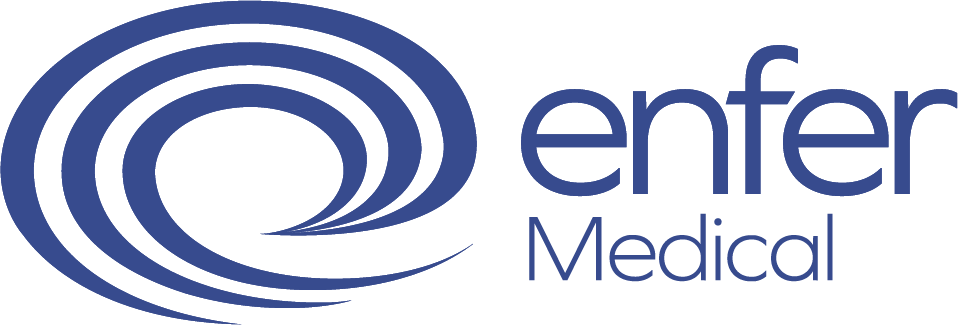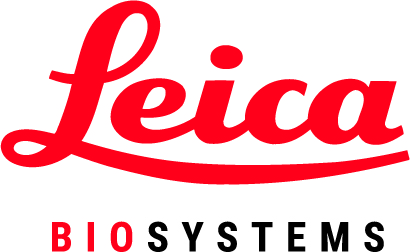The Academy was proud to host BioMedica 2020 – A Virtual Festival of Medical Science.
See the On-Demand Content below:
Virtual Festival On-Demand
Chair: Bernadette Jackson, President of the Academy of Clinical Science and Laboratory Medicine
Welcome Address from Bernadette Jackson, President of the Academy of Clinical Science and Laboratory Medicine
Message from Uachtaráin na hÉireann Michael D Higgins
Opening of the Conference Minister for Health Stephen Donnelly
Keynote Address Dr Siobháin Ní Bhriain, Clinical Lead Integrated Care, HSE
To view the recording, register below:
Chair: Dr. Claire Wynne, Lecturer in Haematology, Undergraduate CPD Coordinator, TU Dublin.
E pluribum Unum: the many causes of Thrombotic Microangiopathy
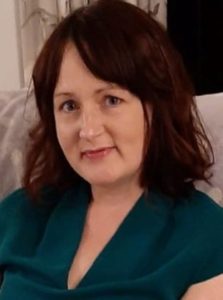 Dr. Maeve Crowley, Consultant Haematologist, Comprehensive Coagulation Centre, Cork University Hospital.
Dr. Maeve Crowley, Consultant Haematologist, Comprehensive Coagulation Centre, Cork University Hospital.
Maeve graduated from University College Cork and did her haematology higher specialist training in Ireland. She was awarded an MD for her work on the coagulopathy associated with plasma cell disorders. On completion of her training, she worked as a consultant haematologist in the Haemostasis and Thrombosis centre in Guy’s and St Thomas’ hospital in London. While there, she was the lead for thrombotic microangiopathy and developed interests in antiphospholipid syndrome and obstetric haematology. She is currently a consultant haematologist in the comprehensive coagulation centre in Cork University Hospital.
Abstract
Thrombotic microangiopathies are a group of disorders characterized by microangiopathic haemolytic anemia, thrombocytopenia and organ damage due to microvascular thrombosis. Though rare, thrombotic microangiopathies are often life-threatening and can require urgent management. Presenting symptoms are often nonspecific, but basic laboratory tests reveal a specific constellation of thrombocytopenia and anaemia with red blood cell fragmentation on the blood film and evidence of haemolysis.
Non-thrombotic effects of platelets.
 Associate Professor Niamh Moran and Steven Cullen , Molecular & Cellular Therapeutics, School of Postgraduate Studies, Royal College of Surgeons Ireland.
Associate Professor Niamh Moran and Steven Cullen , Molecular & Cellular Therapeutics, School of Postgraduate Studies, Royal College of Surgeons Ireland.
Proffessor Niamh Moran is a biochemical pharmacologist who has devoted much of her research career to the understanding of the molecular events underlying platelet activation. She has developed a number of high throughput assays for assessing platelet function that can identify platelet activation in clinical samples. The work of her laboratory has demonstrated independent regulation of platelet activation events in homeostasis and haemostasis, in health and disease.
Abstract: Niamh Moran, Steven Cullen, Brendan McDonnell, Carmen Regan
Platelets play a key role in thrombosis and haemostasis. However recent evidence clearly demonstrates that the functional role of platelets extends to many other processes in the body.
In haemostasis, platelets survey the blood vessels for evidence of damage. Upon detection of endothelial injury, platelets undergo a rapid regulated activation which results in dramatic shape change, adhesion to the exposed sub-endothelial matrix, secretion of important effectors from their dense granules and alpha-granules. The contents of the platelet granules are key to understanding the role of platelets in downstream events. We recently demonstrated that tumour cells directly and specifically induced platelet secretion. Moreover, tumour cell-induced platelet secretion results in the selective release of pro angiogenetic cytokines and mediators, suggestive of a pro-metastatic role for platelets in cancer growth and development.
In parallel, while it is well-established that profound alterations to the blood’s haemostatic balance favouring a pro-coagulant status is observed in normal human pregnancy, little is understood about the role of platelets in pregnancy. We present evidence for temporal, trimester-associated, alterations in platelet function in healthy pregnancy. This nuanced modulation of platelet function associated with progression of pregnancy is suggestive of a functional role for platelet activation during normal gestation. Alterations in platelet activity occur during normal pregnancy have been linked to placental disorders such as pre-eclampsia and fetal growth restriction (FGR). Cigarette smoking increases risk of arterial thrombosis through platelet activation and in pregnancy is a leading cause of FGR. We also demonstrate a differential change in global platelet responsiveness in pregnant women who smoke.
In summary, we will present evidence for the additional role of platelets outside thrombosis and haemostasis, in modulating physiological events as diverse as cancer metastasis and placental development.
To view the recording, register below:
Chair: Fergus Guilfoyle, Chief Medical Scientist, Coombe Womens & Infants University Hospital, Dublin
An Audit of the Appropriate Use of O Rh D Negative Red Blood Cells in a Large Teaching Hospital
Claire Buckley, Medical Scientist, Blood Transfusion, St. James’s Hospital, Dublin
Claire is a Medical Scientist working in The Blood Transfusion Laboratory at St James’s Hospital (SJH). She completed her clinical laboratory placement in SJH and carried out her 4th year research project in the Blood Transfusion Laboratory there. Claire graduated from TU-Dublin in 2019. She majored/minored in Blood Transfusion/Microbiology.
Abstract
This project was designed to investigate if O RhD negative red cell units are being transfused appropriately by auditing their usage in 2018. The main aims were; to examine O RhD negative usage in terms of patient cohort, measure existing blood stock management performance with regards to the optimisation of O RhD negative red cell usage and aid in future forecasting by SJH and the IBTS. These goals were achieved via the development of a purpose built excel datasheet. This datasheet was designed to gather data on all O RhD negative units received by SJH from the IBTS in 2018. The data collected was then statistically analysed.
Some of the results yielded from this project include; Overall RhD Negative usage, O Negative wastage, O Negative usage by Haemoglobinopathy patients and O Negative usage by BMT/PBSCT patients’.
Recruiting Blood donors – There is no tap
 Stephen Cousins, Donor Services Manager, IBTS
Stephen Cousins, Donor Services Manager, IBTS
Stephen Cousins is National Donor Services Manager with the Irish Blood Transfusion Service since 2013, and is responsible for donor recruitment, retention, and marketing. Stephen has post graduate degrees in Marketing, Business & IT operations and Strategic management with over 25 years management experience in the commercial and not for profit sectors.
Abstract
Stephen will look at the challenges of recruiting and retaining blood donors, and how this impacts on maintaining the blood supply.
The National Blood Stock Shortage Plan
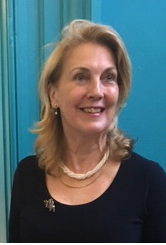 Dr. Joan Power, MB FRCPI, FFPath
Dr. Joan Power, MB FRCPI, FFPath
Clinical Lead Advisor Transfusion Services. Consultant Haematologist, Irish Blood Transfusion Service. Secretary to National Transfusion Advisory Group.
Medical graduate UCC. Initial appointment Consultant Haematologist/ Munster Regional Director, BTSB. Currently Consultant Haematologist IBTS, Medical Director Therapeutic Apheresis Service. Senior Clinical Lecturer UCC. Board member Faculty of Pathology, RCPI. Former Medical Director Munster Musculoskeletal Tissue Bank and Past President British Association for Tissue Banking. Following her identification of the Hepatitis C contamination of BTSB anti-D Immunoglobulin in 1994, National Co-Ordinator to 1997. Awarded UCC Medical Faculty Gold Medal for outstanding contribution to Medicine in Society (2002). Committed to Quality and Clinical Governance frameworks in Health Service delivery, led Munster Centre to ISO and CPA accreditation and contributed at European level to Directives Development.
To view the recording, register below:
Chair: Dr. Claire Wynne, Lecturer in Haematology, Undergraduate CPD Coordinator, TU Dublin
Mutation Status in Myeloid Malignancies informs clinical insight
 Dr Karl Haslam, Senior Scientist, St. James’s Hospital/Genuity Science
Dr Karl Haslam, Senior Scientist, St. James’s Hospital/Genuity Science
After completing a BSc in biochemistry and molecular biology at TU-Dublin, followed by a MPhil in molecular tumour pathology at the Karolinska Institutet, Karl spent 15 years as a clinical scientist in the cancer molecular diagnostics department in St. James Hospital, where he worked with a dedicated team to develop a service with particular focus on progressing molecular diagnostics in malignant myeloid haematological disease. Along the way, he published over 50 peer reviewed articles, acquired an MBA in healthcare management and a PhD by publication.
Karl currently works with a great team at Genuity Science as associate director of the Dublin lab, where they have developed a state of the art genomics facility to support research and development of biomarker discovery programmes.
Abstract
The last decade has seen significant development in understanding the genetic basis of myeloproliferative neoplasms (MPN), with the underlying somatic mutational landscape revealed by genome and targeted exome sequencing. To develop insight into the utility and clinical application of these disease markers, a series of original investigations was conducted.
Initially three recently identified disease-specific molecular markers (mutations in JAK2, CALR and CSF3R) were utilised to measure the burden of disease post-allogeneic transplantation using methods based on quantitative PCR, capillary electrophoresis and Sanger sequencing. All three mutation markers were shown to be stable and robust for monitoring purposes throughout the disease course, inversely correlating with percentage donor chimerism. Increased sensitivity using qPCR in one study highlighted the potential of these disease specific markers to detect molecular and haematological relapse in patients several weeks before clinical manifestation and proved an advantageous adjunct in the clinical assessment of transplantation efficacy.
In a second series of studies, the incidence and significance of recurrent MPN mutations in specific clinical scenarios and MPN disease cohorts was investigated. A baseline for the incidence of JAK2, CALR and MPL mutations in Irish patients referred for suspected MPN was established and shown to be comparable with that of other Western European cohorts. To extend this finding, the incidence and significance of these mutations was investigated in specific clinically relevant disease cohorts, revealing a distinct molecular pathogenesis in paediatric patients with essential thrombocythaemia (ET) when compared to adults, a low incidence of CALR mutations in splanchnic vein thrombosis patients that correlated with the aetiology of the disease and the presence of CALR driver mutations in familial MPN cases. Additionally, the presence of a JAK2 V617F mutation in utero in ET was established for the first time and the dynamic nature of MPN disease clones over the course of disease was revealed, thus informing insight into the clonal evolution and molecular heterogeneity of MPN patients.
In the third series of studies novel next generation sequencing (NGS) technology was applied to investigate somatic mutations in acute myeloid leukaemia (AML) related patient cohorts. A proprietary NGS panel for recurrently mutated genes possessing diagnostic and prognostic significance in AML was evaluated on the Ion Torrent (ThermoFisher) NGS platform across three molecular diagnostic centres in Ireland, Northern Ireland and Scotland. This verified the technique to be robust and reproducible for mutation detection in AML patients. The technology was subsequently deployed to profile mutation status in a clinically high-risk AML patient cohort undergoing transplantation therapy and in a familial AML disease setting to clarify the genotype, reveal the diverse clonal architecture of patients and identify additional driver mutations relevant for existing and emerging therapeutic interventions.
Taken together, these studies inform clinical understanding and decision making in MPN and AML related settings, provide novel insight into underlying mutational status and clonal behaviour in myeloid malignancies and have the potential to translate into optimised and improved treatment for these patient cohorts.
Evaluation of Rotational Thromboelastometry (ROTEM®) in an Irish obstetric population
 Deirdre Duggan, Senior Medical Scientist, Haematology, National Maternity Hospital, Dublin
Deirdre Duggan, Senior Medical Scientist, Haematology, National Maternity Hospital, Dublin
Deirdre Graduated with a BSc Biomedical Science in 2014 from joint CIT/UCC programme. Following a brief stint in Microbiology Deirdre started in the Haematology Laboratory of the National Maternity Hospital in 2017 where her interest for Obstetric Haematology developed. Deirdre graduated with an MSc in Clinical Laboratory Science from TU Dublin in 2019. She is currently working as the Quality Officer for the Deptartment of Pathology & Laboratory Medicine at the National Maternity Hospital.
Abstract
Assessment of maternal haemostatic capacity is a critical component of post-partum haemorrhage management. Recently the utility of standard laboratory testing of haemostasis during obstetric haemorrhage has been questioned. ROTEM® analysis provides a rapid, near-patient assessment of coagulation status which may offer a solution to the limitations of current methods.
The Determination of Paroxysmal Nocturnal Haemoglobinuria clone size in CD71 Positive Red Blood Cells.
Ellen O’Connor, Medical Scientist, Haematology & Blood Transfusion, Rotunda Hospital, Dublin.
Ellen graduated from TU Dublin in 2019. She completed her final year project in the flow cytometry laboratory in the Haematology laboratory in St. James’s Hospital. She now works as a medical scientist in the Haematology/ Blood Transfusion laboratory in the Rotunda Hospital.
Abstract
The size of the RBC clone in PNH is often underestimated due to transfusion or haemolyisis. The superiority of reticulocyte analyses over RBC analyses has been suggested because of its transfusion and haemolysis independency.
The aim of this investigation was to determine the PNH reticulocyte clone size and compare this to the corresponding neutrophil and monocyte clone size. Flow cytometric analysis using the BD FACSCantoTM II flow cytometer was performed on 22 patients. The determination of PNH reticulocyte clone size was made by analysing CD59 expression on CD71 positive red blood cells by flow cytometry
To view the recording, register below:
Chair: Hayley Foy-Stones, Medical Scientist, Haematology Department, St James’s Hospital & Chair of the Engagement and Advancement Advisory Body with the Academy of Clinical Science and Laboratory Medicine.
Interview Skills for Medical Scientists
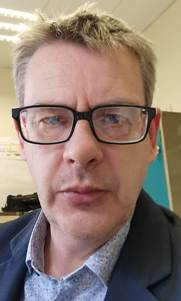 John Crumlish, Laboratory Manager, Mater Misericordiae University Hospital (MMUH)
John Crumlish, Laboratory Manager, Mater Misericordiae University Hospital (MMUH)
John has worked in MMUH since late 2014. Started as Chief Medical Scientist, Blood Transfusion before taking up laboratory manager post in 2017. Prior to this had worked for IBTS for 23 years in a variety of departments, ending as Chief Medical Scientist in Red Cell ImmunoHaematology Reference Laboratory.
Developing the role for Consultant Healthcare Scientists within Pathology – Experiences from the UK.
 Dr. Joanne Horne, Consultant Clinical Scientist in Histopathology, University Hospital Southampton NHS. Consultant Healthcare Scientist in Histopathology, HCPC Registered Clinical Scientist, HCPC Registered Biomedical Scientist.
Dr. Joanne Horne, Consultant Clinical Scientist in Histopathology, University Hospital Southampton NHS. Consultant Healthcare Scientist in Histopathology, HCPC Registered Clinical Scientist, HCPC Registered Biomedical Scientist.
Jo was one of the original participants in the UK national Histopathology Reporting Diploma programme. Since then she has been working as part of the consultant specialty team at Southampton, UK, independently dissecting and reporting gastrointestinal specimens.
Jo is a member of Institute of Biomedical Science (IBMS) Council and deputy chair of the IBMS Membership & Marketing committee. She sits on conjoint boards for the histological dissection and reporting qualifications, and with the National School of Healthcare Science as an examiner for the Scientist Training Programme (STP), and as lead editor for the histopathology STP curriculum review. Jo is part of a working group reviewing Healthcare Scientist training pathways within histopathology and is passionate about their development and promotion.
Jo’s other interests include compassionate leadership and the use of media to engage, inform and promote the profession, having recently created a website for current and aspiring Healthcare Scientists. She also provides educational support, advice and mentoring to colleagues and peers.
Abstract:
Advanced practice in histopathology dissection is long established within the UK. In 2012, a pilot scheme was launched to train Healthcare Scientists in histopathology reporting, as there was increasing awareness of the impending workforce crisis within the specialism. As one of the pilot participants I have been involved in training within the UK since the beginning and was in the first cohort to pass the examination and gain certification in gastrointestinal histopathology reporting. This has enabled me to practice independently since 2016 and I was appointed into a Consultant post earlier this year. This talk will firstly look at the training and experiences of those of us who have undertaken the UK histopathology reporting programme. There will then be focus on the wider strategy within the UK relating to advanced and consultant practice for scientists within Pathology. Finally, I will offer some advice on how the same developments might be designed and implemented within Ireland, based on experiences from the UK over the last eight years.
Health Service Staff Credit Union – Funding Postgraduate Studies
 Pádraig Power, Health Service Staff Credit Union, Marketing Manager
Pádraig Power, Health Service Staff Credit Union, Marketing Manager
Abstract: Pádriag is providing an overview of the services available to medical scientists from the Health Service Staff Credit Union and the eight most common methods of funding various types of postgraduate studies.
MLSA – Funding Postgraduate Studies
Patrick Naughton, MLSA Treasurer
Treasurer of the MLSA: I work as a medical scientist in the Haematology department of the Mercy University hospital in Cork. I have been an active member of the MLSA for a number of years, occupying the role of local union representative before being elected onto the MLSA national executive board in 2015. I currently serve as Treasurer of the organisation having been elected to the post by the board in 2017. I am a member of the ACSLM and value the importance of having an independent academic body to oversee the profession and maintain its educational and professional standards. I am currently carrying out a research PhD in infectious mononucleosis with a particular emphasis on the laboratory results while also examining the traditional and potential role of the medical scientist in the detection and management of the disease.
Couch Panel: How COVID-19 has impacted the lives of early career Medical Scientists
Clinical Placement during COVID-19 pandemic
Clíona O’Shea, Medical Scientist, Molecular Microbiology, CHI at Crumlin
Cliona graduated from the joint CIT/UCC Biomedical Science course in 2019. She then went on to complete the 5th Year Postgraduate Diploma in Clinical Laboratory Practice. Cliona worked in the microbiology laboratory in the Mercy University Hospital as an ‘intern medical scientist’ from April to June 2019. She is currently working in the Molecular Microbiology Laboratory in Children’s Health Ireland at Crumlin.
Abstract: Early in 2019, the onset of the COVID-19 pandemic greatly disrupted the lives of clinical placement students and medical scientists in hospital laboratories. From the perspective of a student in the Mercy University Hospital in Cork, this meant a truncated placement, interruption to laboratory research project, and considerable uncertainty about the outcome. For the medical scientists in the microbiology laboratory in the MUH, challenging demands were met including the splitting of staff into two teams, altered shifts, and the implementation of diagnostic tests for SARS-CoV-2. The resulting transition from the position of student to ‘intern medical scientist’ in microbiology in the middle of placement was challenging but rewarding. The devotion, resilience and flexibility shown by medical scientists at this time was a pleasure to witness and a memorable part of this experience. The skills and knowledge that were gained in this laboratory led to the acquisition of a position in the Molecular Microbiology Laboratory in CHI at Crumlin.
Experiences as a PhD student in CIT and as a medical scientist (MUH) since March 2020.
Caoimhe Lynch, Medical Scientist, Haematology, MUH, Cork & PhD Candidate in Microbiology with a focus on Campylobacter, CIT.
Abstract
B.Sc (Hons) Biomedical Science graduate (2015), Diploma in Clinical Laboratory Practice – Cork University Hospital (CUH) (2016). Worked as a medical laboratory assistant and medical scientist in the Haematology Dept. of CUH. Returned to Cork Institute of Technology (CIT) in 2017 to start a PhD centred on Campylobacter spp. under the supervision of Professor Aidan Coffey and Dr. Brigid Lucey, funded by the Department of Agriculture Food and the Marine on a Teagasc Walsh Fellowship. Began working as a medical scientist in the Haematology Department of the Mercy University Hospital (MUH) at the end of March 2020. Continuing work on the PhD throughout lockdown.
An insight into the life of a biomedical science intern at Cork University Hospital during the COVID-19 Pandemic
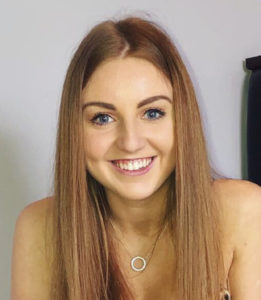 Niamh Walsh, Clinical Placement Student, CIT/CUH. Biomedical Science Intern Cork University Hospital.
Niamh Walsh, Clinical Placement Student, CIT/CUH. Biomedical Science Intern Cork University Hospital.
Niamh Walsh is currently completing a Diploma in Clinical Laboratory Practice in Cork University Hospital. She has recently graduated from Cork Institute of Technology and University College Cork with a degree in Biomedical Science. She has just completed her rotation in the Microbiology laboratory which began on the 7th September 2020. She will be speaking about her experience to date working in a hospital laboratory as a student during this pandemic in particular about her time in the Microbiology laboratory.
Mentors Programme – Expression of Interest for Mentees
Hayley Foy-Stones, Medical Scientist / Chair of Engagement and Advancement Advisory Body
Medical Scientist, St James Hospital & Chair of Engagement and Advancement Advisory Body. Chair of the Engagement & Advancement Advisory Body with the ACSLM. This Advisory Body was established in 2019 to focus on the advancement of Medical Scientists in Ireland. Hayley works as a Medical Scientist in Haematology, including the specialised area of Stem Cell and Bone Marrow Transplantation.
Hayley will present the Mentors Programme update on behalf of the Engagement and Advancement Advisory Body. National call for Mentees to complete Expression of Interest Questionnaire
Live Panel Q & A
To view the recording, register below:
Chair: Maria Molloy, Laboratory Manager, University Hospital Galway
Update on COVID-19. Q&A session
 Dr Michael Ryan, Executive Director, WHO Health Emergencies Programme
Dr Michael Ryan, Executive Director, WHO Health Emergencies Programme
Dr Mike Ryan has been at the forefront of managing acute risks to global health for nearly 25 years. He served as Assistant Director-General for Emergency Preparedness and Response in WHO’s Health Emergencies Programme from 2017 to 2019.
Dr Ryan first joined WHO in 1996, with the newly established unit to respond to emerging and epidemic disease threats. He has worked in conflict affected countries and led many responses to high impact epidemics. He is a founding member of the Global Outbreak Alert and Response Network (GOARN), which has aided the response to hundreds of disease outbreaks around the world. He served as Coordinator of Epidemic Response (2000-2003), Operational Coordinator of WHO’s response to the SARS outbreak (2003), and as WHO’s Director of Global Alert and Response (2005-2011),
He was a Senior Advisor on Polio Eradication for the Global Polio Eradication Initiative from 2013 to 2017, deploying to countries in the Middle East.
He completed medical training at the National University of Ireland, Galway, a Master’s in Public Health at University College Dublin, and specialist training in communicable disease control at the Health Protection Agency in London and the European Programme for Intervention Epidemiology Training.
Sars-CoV-2: a year is a long time in Virology!
 Dr Cillian De Gascún, Director of National Virus Reference Laboratory
Dr Cillian De Gascún, Director of National Virus Reference Laboratory
Cillian De Gascun is a consultant virologist who graduated from Trinity College Dublin in 1998. He undertook his basic medical training in Dublin and Brisbane, returning to Dublin in 2002, and completed his specialist virology training in the National Virus Reference Laboratory (NVRL) at University College Dublin (UCD) and Bart’s & The London NHS Foundation Trust in London. He is a Fellow of the Royal College of Physicians of Ireland (FRCPI), a Fellow of the Royal College of Pathologists in the UK (FRCPath) in Virology, and a Fellow of the Faculty of Pathology of the RCPI. His MD was awarded in 2011 by UCD for work carried out in the NVRL under the supervision of Professors William Hall and Colm Bergin. The primary focus of the MD was to describe the molecular epidemiology of HIV-1 in Ireland, but the work also documented the prevalence of antiretroviral transmitted drug resistance in Ireland over a five-year period (2004 – 2008). Following two years spent as a consultant virologist with Surrey Pathology Services in the UK, Cillian was appointed Director of the National Virus Reference Laboratory and returned to Ireland permanently in 2013. His main research interests continue to be in the area of the molecular epidemiology of viruses, antiviral resistance, vaccine-preventable infections, and the utilisation of these data to inform national health policy. In January 2020, Cillian was asked to chair the SARS-CoV-2 Expert Advisory Group, a subgroup of the National Public Health Emergency Team.
Abstract:
In just over 10 months, the world has gone from the publication of the genetic sequence of a novel coronavirus with pandemic potential to the publication of preliminary data from three phase 3 clinical trials for different vaccine candidates against that noel pathogen. From bats and pangolins to possible vaccine-escape mutants in mink, this presentation will provide an overview of the 2020 SARS CoV 2 pandemic from the virologist’s perspective.
SARS-CoV-2 testing in a Paediatric Setting: A CHI at Crumlin Experience
Dr. Adele Habington, Chief Medical Scientist, Molecular Laboratory, Childrens Health Ireland (CHI) at Crumlin.
I grew up in Brisbane, Australia and was awarded my Bachelor of Science in Microbiology from the University of Queensland in 1994. When I was 21 I moved to Dundee, Scotland and studied for my Doctor of Philosophy. My project was titled ‘Investigation of the role of PEBV RNA2 5’ noncoding sequences in RNA replication and protein expression.’ My PhD work was mainly molecular based and gave me an excellent start in this area. In 1998 I moved to Dublin where I worked in the National Children’s Research Centre at Our Lady’s Children’s Hospital Crumlin studying Campylobacter upsaliensis. Then in 2002 I moved 50 metres away to the Microbiology Laboratory at Crumlin Hospital and did my 1 year in-service training to allow me to work as a Medical Scientist in Microbiology. I have worked in the Microbiology Department in CHI at Crumlin ever since, moving into the area of Molecular testing as a Senior Medical Scientist in 2007. In 2016 I became the Chief Medical Scientist in the Molecular Microbiology section of the Microbiology Laboratory overseeing PCR and serology testing in the laboratory.
Abstract
Background:The provision of a robust testing system for the detection of Sars-CoV-2 in respiratory samples is an important component in the management of hospital patient and staff in the current pandemic. The lack of availability of sufficient rapid PCR testing cartridges has meant that the focus of PCR testing is primarily in the area of the higher throughput but slower batch based PCR testing.
The groups of patients who require testing are patients exhibiting respiratory symptoms and pre-operative patients who are undergoing procedures which may generate aerosols. Staff testing is also performed on-site and this facilitates rapid contact tracing and permits the return of staff to work.
Aim: Our aim was to provide a batch based PCR system for the testing of samples for Sars-CoV-2.
Methods: The initial method of choice was based on the equipment already available in the Molecular Section of the Microbiology Laboratory. The method consisted of sample lysis, sample extraction using the QIAsymphony SP, followed by real-time PCR using the Anatolia Geneworks Bosphore PCR kit and the ABI FAST PCR system. Initially, test validation was performed using positive sample panels from the National Virus Reference Laboratory and External Quality control samples. In June 2020, an additional testing system was added, the Seegene All-In-One Platform. Both of these testing systems take between 5-6 hours from sample to result.
Results: Since March 25 2020, the Molecular Microbiology has been providing a testing service for Sars-CoV-2 detection in respiratory samples of patients and staff. Over 6000 samples were tested by November 2020, with a positivity rate of 1.98%
To view the recording, register below:
Presentations will be available shortly.
Chair: Sinéad Creagh, Laboratory Manager, Cork University Hospital
A Systematic Analysis of laboratory-Guided Diagnosis and Management of COVID-19: Challenges and Recommendations
Shane Whelan, Department of Biological Sciences, CIT Cork
Shane Whelan is a PhD candidate at Cork Institute of Technology with an undergraduate degree in pharmaceutical biotechnology. His research concerns bacterial biofilms as they relate to human disease and antibiotic resistance. Since the emergence of the COVID-19 pandemic he expanded his research to include laboratory testing and diagnosis of COVID-19.
Abstract: We conducted a comprehensive analysis of patient demographics and laboratory tests encompassing Real Time PCR (RT-qPCR) and serology for SARS-CoV-2 in addition to blood components and clinical blood markers for COVID-19 disease. We found that nasopharyngeal swabs are the most suitable samples based on detection rates by sample for RT-qPCR, but may require repeat testing. One-week post-symptom onset, serological testing is a more stable marker. Antibody titers have been linked to disease severity. Several clinical blood components and markers have been reported to be prognostically useful; however, care is needed when making interpretation owing to the association between raised levels of these being found for the co-morbidities that predispose to worse prognosis in COVID-19. The challenges finding the information presented in this paper suggest the potential usefulness for a quality assured database that outlines the complete set of results, anonymised patient data for each entry and a set of internationally-agreed guidelines for complete laboratory testing, documentation and open-access reporting. We suggest that such information would be useful to help with patient diagnosis and management, worldwide.
Tallaght University Hospital Antibody Study
 Caroline Murray, Senior Medical Scientist, Tallaght University Hospital and Phyllis Reilly, Senior Medical Scientist, Tallaght University Hospital
Caroline Murray, Senior Medical Scientist, Tallaght University Hospital and Phyllis Reilly, Senior Medical Scientist, Tallaght University Hospital
Caroline Murray – Senior Medical Scientist, Tallaght University Hospital. Phyllis Reilly, Senior Medical Scientist, Tallght University Hospital. Caroline graduated from UCC/CIT Biomedical Science in 2008 and completed her training in Waterford University Hospital, where she worked in Biochemistry and Haematology labs for 2 years before moving to Biochemistry/Metabolic labs in Temple St Children’s University Hospital in 2011. She completed the MSc in Clinical Chemistry in 2015 through TCD and started as Senior Medical Scientist in Clinical Chemistry, Tallaght University Hospital in 2017.
Phyllis graduated from Dublin Institute of Technology Biomedical Science in 2009 majoring in Clinical Chemistry. Phyllis began working as a medical scientist in the Clinical Chemistry laboratory Tallaght University Hospital in 2010. She completed the MSc in Clinical Chemistry in 2016 through TCD. She began working as a Point of Care Medical Scientist in the Laboratory Medicine Department Tallaght University Hospital in 2016 and started working as a Senior Medical Scientist in the Clinical Chemistry department Tallaght University Hospital in 2018. Caroline and Phyllis are an integral part of the TABS team and played a pivotal role in the completion of Phase 1 of the project. They used their extensive method verification knowledge to aid in the development of the anti-SARS-CoV-2 service as well as the overall study design and implementation. Both ladies are now heavily involved in Phase 2 of TABS as well as a number of other key research projects in the Laboratory Medicine Innovation Hub at TUH led by Dr Ann Leonard, Professor Gerard Boran and Dr Anna-Rose Prior.
Abstract:
Since the onset of the COVID-19 pandemic, healthcare workers are generally considered at higher risk of SARS-CoV-2 exposure and infection acquisition than the general population. Phase 1 of this study aimed to evaluate SARS-CoV-2 seroprevalence in healthcare workers (HCWs) in Tallaght University Hospital and correlate seroprevalence with known or suspected SARS-CoV-2 infection in this population since the onset of the pandemic.
Presentations will be available shortly.
Chair: Karen Hickey, Senior Medical Scientist, Microbiology Laboratory, Sligo University Hospital
Diagnostic accuracy of Gram stain (Hay’s criteria) against BV PCR for diagnosis of bacterial vaginosis
Thomas Murphy, Medical Scientist, Rotunda Hospital.
Medical Scientist, Rotunda Hospital. I am from Portrane, North County Dublin. I started out as a Medical Laboratory Assistant in Cappagh Hospital in 2013. In 2014, I worked as a Medical Laboratory Assistant in the Rotunda Hospital and from here I qualified as a Medical Scientist in March 2017. I have been working in the Rotunda Hospital as a medical scientist ever since. I recently completed my Msc. and my project was on comparing the Seegene analyser versus gram stain for diagnosing BV.
Abstract
BV can cause complications in pregnant women that include; low birth weight, premature rupture of membranes and chorioamnionitis. Diagnosis is by Gram stain of a vaginal smear based on Hay’s criteria. The main problem with this method is the inter- rater reliability of interpreting the Gram stain among scientists. The Seegene Allplex BV panel is a multiplex real-time PCR assay that can be used for the quantitative/qualitative detection of bacteria that cause BV. 200 Gram stain impressions from high vaginal swabs were made and then inoculated into the liquid medium for PCR and then analysed. The results of both methods were compared. Lactobacilli were more commonly identified in normal swabs, where AV and GV were associated with BV. The use of PCR will eliminate the inter- variability of gram stain results. This study has showed that using BV PCR is a viable alternative for diagnosis of BV.
Establishment of the prevalence of Mycoplasma genitalium and its associated macrolide resistance in the South East of Ireland and evaluation of two Real Time-PCR assays
Laura Johnson, Medical Scientist, University Hospital Waterford.
Abstract:
Mycoplasma genitalium is a sexually transmitted organism found primarily in the urogenital tract. It is a recognised cause of urethritis in men and is associated with pelvic inflammatory disease in women. Marcolide antibiotics such as azithromycin, have long been used as the first line treatment for this infection, however this treatment is becoming less effective due to increasing resistance. Traditional culture of this organism from clinical samples is not routinely performed due to the extremely fastidious and slow growing nature of Mycoplasma genitalium. Use of nucleic acid amplification testing offers a viable diagnostic solution for the detection of Mycoplasma genitalium in routine laboratories. As currently Mycoplasma genitalium testing is only available from the national reference laboratory all at risk patients are not tested, treatment is empirical and the true prevalence is unknown. In this study two Real Time-PCR assays, the SpeeDx Resistance® Plus MG and the TIB MOLBIOL- LightMix® Kit Mycoplasma genitalium (EC) were evaluated on the fully automated Roche LC480II LightCycler® to detect Mycoplasma genitalium. Positive samples were then further evaluated for macrolide resistance and a comparative analysis was performed between each RT-PCR assay.
To view the recording, register below:
The virology of COVID-19 (Video)
Dr. Brendan Crowley, Consultant Microbiologist, St James Hospital, Dublin
To view the recording, register below:
Chair: Dr. Fidelma Hernon, Senior Medical Scientist, Blackrock Clinic
Whole Genome Sequencing: Diagnostic Friend or Foe?
Dr Peter Flanagan, Ph.D, Clinical Scientist – Irish Mycobacterium Reference Laboratory
Visiting Fellow – Trinity College Dublin, Clinical Microbiology, School of Medicine
Dr. Flanagan has over 10 years of experience working in the higher education sector and diagnostic laboratories in the UK and Ireland as a Research Assistant, Postgraduate Research Fellow and Clinical Scientist.
Upon graduating from NUI Maynooth with a B.Sc. in Biological Sciences, Dr. Flanagan was offered a Research Assistant position at The University of Oxford, Nuffield Dept. of Clinical & Experimental Medicine. Here, he spent 2 years working as part of a multidisciplinary team on the SPARTAC trial where he was responsible for longitudinal target sequencing of samples from patients acutely infected with HIV.
Following this, Dr. Flanagan completed his Masters in Virology at Imperial College London which focused on molecular biology and pathology of viruses. Shortly later, Dr. Flanagan successfully secured a place to complete a Ph.D. in molecular microbiology of the fungal pathogen Candida albicans at the Dublin Dental University Hospital, Trinity College Dublin.
After his education, Dr. Flanagan was later appointed to Postdoctoral Fellow and pioneered the implementation of 3rd generation sequencing to the molecular microbiology group within the Dublin Dental Hospital using Oxford Nanopore Technology and the use of their portable MinION sequencer. He also developed the bioinformatic pipeline within his immediate research group and beyond in order to analysis sequences.
Abstract
Currently, Dr. Flanagan is undertaking work in the Irish Mycobacteria Reference Laboratory to develop and deploy a WGS pipeline for the rapid identification of Mycobacterium tuberculosis recovered from patient samples and determining drug resistance. His role sees him collaborating with the National MRSA Reference Laboratory and Interim Gonococcal Reference laboratory as they develop WGS as a diagnostic tool.
To date, hospitals are facing a larger incidence of difficult to treat infections due to increasing drug resistance and newly derived infectious agents such as SARS-CoV-2. Strain identification, as well as virulence and drug resistance profiling can be a timely task. Moreover, current phenotypic tests are limited in the information that they provide. Until recently, whole genome sequencing (WGS) has been a tool utilised by research institutes the world over. However, in recent years more evidence is mounting, suggesting that WGS can be of substantial benefit in a clinical diagnostic setting. In particular, WGS can provide enhanced information on drug resistance, bacterial fitness factors, horizontal gene transfer, multi-locus sequence typing but also, provide an understanding of transmission. Furthermore, genomic analysis can provide vital information into the relatedness of samples during an outbreak regionally, nationally and globally, allowing epidemiological connections as well as contact tracing.
Microarray-based Epigenetic Classifier for Brain Tumours
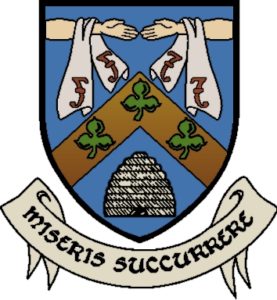 Teresa Loftus, Senior Medical Scientist, Beaumont Hospital
Teresa Loftus, Senior Medical Scientist, Beaumont Hospital
I am a Specialist Medical Scientist in the Molecular Laboratory in Beaumont Hospital. Having completed an MSc in Molecular Medicine from Trinity College Dublin, I became a Fellow of the Academy of Clinical Science and Laboratory Medicine (ACSLM), and sit on the advisory board for Molecular Diagnostics for the ACSLM. I am a quality assessor for the Central Nervous System Cytogenomic External Quality Assurance Scheme (CEQAS). Recently Beaumont Hospital embarked on a laboratory modernisation project which included upgrading the molecular facility. This involved overseeing the move of all instrumentation to the newly located laboratory and the revalidation of all instrumentation and assays to the ISO15189 international standard.
Beaumont Hospital is the national referral centre for all Paediatric and Adult molecular neurooncology. We perform an array of assays, including techniques such as real time PCR, pyrosequencing, array comparative genomic hybridization and Next Generation Sequencing. In 2019 we set about introducing DNA methylation profiling within the department.
Abstract:
DNA methylation profiling of brain tumours has proven to be very useful in the medical setting in recent years. It has important diagnostic, prognostic and treatment implications. It was set up in the Molecular lab in Beaumont Hospital in 2019 to facilitate the needs of paediatic and adult neurooncology patients. Using this technology, the data generated is analysed to determine a tumour classification, copy number profile and MGMT methylation result.
To view the recording, register below:
Chair: Fergus Guilfoyle, Chief Medical Scientist, Coombe Women and Infants University Hospital.
The identification and management of Anti-Jk3 in pregnancy
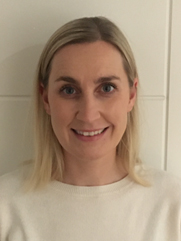 Cait Geaney, Senior Medical Scientist, Red Cell Immunohaematology Laboratory, Irish Blood Transfusion Service, James’s St. Dublin 8
Cait Geaney, Senior Medical Scientist, Red Cell Immunohaematology Laboratory, Irish Blood Transfusion Service, James’s St. Dublin 8
Since graduating from D.I.T in 2009, Cáit worked in Crumlin Transfusion and Haematology Laboratory’s for 3 years and worked in a Medical and Pharmaceutical Laboratory’s in Melbourne, Australia for 4 years. Since returning from Australia she has worked in the Irish Blood Transfusion Service. She completed an MSc in Biomedical Science (2018) which focused on antenatal testing in the Red Cell Immunohaematology Laboratory. Cáit is a Senior Medical Scientist in charge of antenatal testing in the RCI laboratory and rare reference cell co-ordinator. Today she will present a recent case where anti-Jk3 was detected in a pregnant patient.
Abstract:
The Kidd-null phenotype Jk(a-b-) occurs in individuals who do not express the JK glycoprotein. The Kidd blood group system contains three antigens: Jka, Jkb and Jk3. Anti-Jk3 is a high incidence antigen present in more than 99.9% of populations. Jk(a-b) individuals can make an antibody against the Jk3 antigen. Jk(a-b-) is the rare null phenotype commonly found in Polynesians. Kidd antibodies may cause acute and delayed haemolytic reactions as well as haemolytic disease of the fetus and newborn (HDFN).
We present a case of a pregnant 45 year old female where anti-Jk3 was identified. The process of antibody identification, antibody titration throughout her pregnancy will be discussed. In addition the complexity of trying to source blood for this patient; targeted screening of the Irish donor population and importation of blood from the European Union to cover delivery.
Results: On initial workup the patient grouped as ORhD positive a historical red cell phenotype was available C+ E- c- e+ M+ S- s+ K- Fy(a+b-) Jk(a-b-). Pan reactivity was observed by the indirect antiglobulin test (IAT) and by enzyme-IAT technique. Using rare Jk (a-b-) cells from the RCI repertoire of rare reference cells negative reactions were obtained. To ensure there were no other clinically significant antibodies detectable adsorption techniques were performed. Throughout her pregnancy antibody titrations were performed. Titrations are performed using the Kidd phenotypes: Jk(a-b+), Jk(a+b-) and Jk(a+b+) to indicate the requirement for Fetal Medicine Specialist unit referral.
Conclusion: The provision of blood for these patients does require importation of units if suitable blood cannot be sourced in the country. Jk3- negative people are most likely to be found in Polynesians, South East Asians and Finns. Liquid donations and frozen units from the bank were sought to cover delivery. Siblings of patients with anti-Jk3 should be tested for compatibility and the patient also and patients are urged to donate blood for cryogenic storage.
To view the recording, register below:
James Harte, CIT/UCC
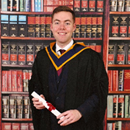 Biographical detail
Biographical detail
James Harte is a graduate of the BSc (Honours) in Biomedical Science from CIT/UCC. James achieved a first-class honours ranking at third-level, consistently scoring highest in his class and was recognised as the ’Best Honours Degree Student’ in BSc (Honours) in Biomedical Science and ’Best Honours Degree Student’ in the School of Science and Informatics at Cork Institute of Technology. During his time as an undergraduate, this recognition was documented by several nominal honours including successive ‘College Scholar’ titles for achieving first-class honours, successive ‘Faculty Scholar’ titles for ranking first-in-class, and three, highly prestigious ‘Quercus College Scholarships’ for exceptional examination results. In 2017, James was awarded the highly competitive ‘Quercus University Scholarship’ for consistent academic excellence, a distinction bestowed on a single student each year. His curiosity for scientific endeavour has also driven an extraordinary engagement with academic research, including experience as a research assistant in the Centre for Research in Advanced Therapeutic Engineering at CIT; one-of-eight APC Microbiome Institute Summer Studentships, conducting an independent metagenomic project; a research survey into antimicrobial resistance in Ireland, which is currently in preparation for publication, and one-of-twenty distinguished Europe-wide Amgen Scholarships, which supported intensive research at the University of Cambridge. His final year project, under the supervision of Dr. Justin McCarthy at University College Cork, characterised the sequential proteolysis of a novel gamma-secretase substrate. Subsequently, he was retained as a research intern to continue aspects of the characterisation, and his experimental data will form part of a forthcoming publication. In addition to his avidity for science, James has a keen interest in teaching and learning. He has been a tutor at first-, second-, and third-level for many years, fastening his abiding love for science with community engagement. As a tutor, James takes pride and pleasure in distilling complex concepts into their most basic components, and has taught several undergraduates fundamental and advanced laboratory skills during his time as a research intern at University College Cork. James also engaged in a variety of recognised student activities, including standing as the academic representative for his year group, writing articles for the UCC Express in Irish and in English, partaking in societal offices, and speaking at student-focused events. His engagement with the profession of medical science has been pivotal in hammering and forging James’ personality. He holds three axiomatic principles close to his heart: the pursuit of personal development and identity; the pursuit of professional development and higher education; and the pursuit of life-long happiness. As he embarks on the next stage of his journey, he hopes to continue to challenge himself at every possible level, to advance his own knowledge and understanding of medical science, and hopefully, to contribute to the ever-expanding field of medical research in a way which is beneficial to the greater population as a whole.
ANGIOTENSIN-CONVERTING ENZYME 2 (ACE2) IS A NOVEL SUBSTRATE FOR γSECRETASE-DEPENDENT INTRAMEMBRANE PROTEOLYSIS.
DISCIPLINE: Clinical chemistry
AUTHORS: Harte, J.V.1,2, McCarthy J.V.3
1 Department of Biological Sciences, Cork Institute of Technology, Rossa Avenue, Bishopstown, Cork, Ireland.
2 School of Biochemistry and Cell Biology, University College Cork, College Road, Cork, Ireland.
3 Signal Transduction Laboratory, School of Biochemistry and Cell Biology, ABCRF, 3.41 Western Gateway Building, Western Road, University College Cork, Cork, Ireland.
ABSTRACT:
Introduction: The renin-angiotensin system (RAS) is a critical component of the response to hypovolaemia and hypotension; however, RAS dysfunction is an appreciable mechanism of disease1. The recently discovered angiotensin-converting enzyme 2 (ACE2) is known to counterregulate the potentially destructive effects of uncontrolled angiotensinergic activity2. Subversion of ACE2 by pathophysiological conditions, including infection by zoonotic coronaviruses, can contribute to inappropriate activation of the RAS and accentuate inflammatory and fibrotic disease. Although ACE2 is known to undergo ectodomain shedding, a feature shared by many substrates of γ-secretase-dependent regulated intramembrane proteolysis3, no studies have investigated the subsequent cleavage of the ACE2 carboxyl-terminal fragment (CTF).
Materials and Methods: The molecular mechanism of ACE2 cleavage following ectodomain shedding was investigated by Western blot analysis in cultured cells expressing exogenous or endogenous ACE2 using pharmacological inhibitors and genetic deficiency of presenilin. The subcellular localization of γ-secretase-dependent proteolysis was also investigated using inhibitors of clathrin-dependent endocytosis.
Results: In this study, we show that following ectodomain shedding, the membrane-bound ACE2 CTF is subsequently cleaved by γ-secretase, and that specific biochemical and genetic loss of γsecretase activity independently compromise sequential cleavage of ACE2. Pharmacological inhibition of proteasomal degradation also revealed a putative γ-secretase generated ACE2 intracellular domain (ICD). Moreover, we show that clathrin-mediated internalization of ACE2 is necessary for γ-secretase-dependent proteolysis.
Conclusions: These observations demonstrate that ACE2 is a novel γ-secretase substrate and the formation of a potentially biologically active intracellular domain may be partly responsible for the counter-regulation of the “classical” RAS. Internalization-dependent cleavage may also partly explain the uptake of zoonotic coronaviruses. Thus, the identification of ACE2 as a γ-secretase substrate may facilitate translational approaches for manipulating RAS activity in vivo, with potential biomedical significance in terms of health and disease.
REFERENCES:
1. Forrester S, Booz G, Sigmund C, Coffman T, Kawai T, Rizzo V, et al. Angiotensin II Signal Transduction: An Update on Mechanisms of Physiology and Pathophysiology. Physiological Reviews. 2018;98(3):1627-1738.
2. Paz Ocaranza, M, Riquelme, J, García, L, et al. Counter-regulatory renin–angiotensin system in cardiovascular disease. Nature Reviews Cardiology. 2020;17(2):116-129.
3. McCarthy, A, Coleman-Vaughan, C, and McCarthy, J. Regulated intramembrane proteolysis: emergent role in cell signalling pathways. Biochemical Society Transactions. 2017; 45(6); 1185– 1202.
Clodagh Lalor, GMIT
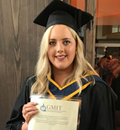 Biographical Detail
Biographical Detail
I successfully graduated with a BSc. in Medical Science from GMIT and completed my placement in University Hospital Limerick (UHL). Following this, I took a keen interest in Clinical Chemistry and worked in the Biochemistry Dept. as a student medical scientist and further completed a final year project in the laboratory. I majored in Clinical Chemistry and Medical Microbiology in 2019 after which I began working in the Biochemistry Laboratory, UHL and I am working there to this day.
Abstract
EVALUATION OF A FAECAL CALPROTECTIN ASSAY FOR INTRODUCTION INTO ROUTINE TESTING IN BIOCHEMISTRY LABORATORY, UHL
Discipline: Clinical Chemistry
Authors: (1) Lalor C, McGrath M, Conmy B.
(1) Riversdale, North Circular Road, Limerick.
Institution: Dept. of Biochemistry, University Hospital Limerick in collaboration with Dept. of Biopharmaceutical and Medical Science, Galway-Mayo Institute of Technology.
Introduction: Faecal calprotectin (FC) is a routinely used, non-invasive biomarker for the diagnosis and monitoring of Inflammatory Bowel Disease (IBD) [1]. The primary aim of this study is to evaluate the Bühlmann fCAL faecal calprotectin turbo assay in order to bring FC testing into routine testing on site in University Hospital Limerick (UHL).
Material and Methods: The performance characteristics of fCAL turbo assay were verified on the Abbott Architect C16000 analyser. Precision was carried out by analysing two levels (low and high) of Internal Quality Control (IQC) in three replicates, daily for five days. Accuracy was measured by analysing nine EQA samples. Additionally, a comparison study was performed which involved the measurement of 20 patient samples on both the Abbott Architect C16000 and Phadia 250 instrument.
Results: The precision study confirmed consistency with the manufacturer’s claims and revealed a total coefficient of variation (CV) of 1.53% and 3.8%, respectively. A high percentage inaccuracy of 21.83% and significant negative bias was observed for accuracy studies. A percentage bias of 88.9% and Passing-Bablok analysis revealed poor agreement between the two methods, further emphasised by a p value of 0.007 (α=0.05). The null hypothesis was thereby rejected.
Conclusion: The fCAL turbo assay performed in accordance with the manufacturer’s specifications of precision. However, accuracy and method comparison results were unsatisfactory for the verification of the assay. Further analysis is required before introduction of the assay into routine testing. Once the analytical performance is evaluated successfully, the assay will be implemented on site, drastically reducing turnaround times, decreasing referral costs and improving service to users.
References: [1] Seenan JP, Thomson F, Rankin K, Smith K, Gaya DR. Are we exposing patients with a mildly elevated FC to unnecessary investigations? Frontline Gastroenterology. 6th ed. 2015; 156-160.
Ciara Liptrot, GMIT
 Biographical Detail
Biographical Detail
I studied Medical Science at the Galway Mayo Institute of Technology graduating in November 2019. In my final year of study I chose to specialise in Haematology, Blood Transfusion and Cellular Pathology. Throughout college blood transfusion and haematology were my favourite modules. I was fortunate to have had the opportunity to carry out my final year research project in the Red Cell Immunohaematology laboratory (RCI) at the Irish Blood Transfusion Services. Here I began my career as a medical scientist and got to see aspects of my research project validated and adopted into routine practice. Working in the RCI laboratory, I gained great Blood Transfusion knowledge and experience. I have recently begun working in the Coombe Women and Infants University Hospital Haematology and Transfusion laboratories where I hope to further develop my Haematology knowledge and Blood Transfusion expertise.
Abstract
Improving the Process of Mitigating Daratumumab Interference in Pre-transfusion Compatibility Testing
Liptrot, C., Cregg, H., Scally, E.
Galway-Mayo Institute of Technology, Old Dublin Rd, Galway
Irish Blood Transfusion Services, National Blood Centre, St. James’s Street, Dublin 8
Transfusion and Transplantation Science
Multiple myeloma (MM) is a malignant plasma cell disorder. Daratumumab (DARA), a monoclonal antibody directed against CD38, may be used for the treatment of MM as CD38 is over expressed on the malignant plasma cells¹. Treatment with DARA, however, interferes with pre-transfusion compatibility testing as DARA binds CD38 on reagent red cell. Several methods may be utilised in order to mitigate DARA interference including DTT treatment of reagent cells and masking CD38 present on reagent-cells. The aim of this research was to improve the current process of mitigating interference due to DARA in pre-transfusion compatibility testing.
The utility of extending the shelf life of DTT-treated reagent red cells was assessed. Batch DTT-treated reagent red cells remained stable for up to 28 days post treatment. However, based on this study, due to haemolysis of cells and a decrease in reaction strength of some red cell antigens by day 28, the shelf-life of DTT-treated cells should be extended no longer than 14 days.
The validity of a room temperature crossmatch for patients who have been administered DARA and have a negative antibody screen was also assessed. Using NaCl gel cards, 22 patient plasma samples containing DARA were crossmatched against group O Rh D negative donor cells with compatible reactions observed. The implementation of a room temperature crossmatch would eliminate the need to DTT-treat donor red cells for compatibility testing and thus reducing laboratory turnaround-times.
The efficacy of DaraEx, an anti-CD38 neutralizing agent was evaluated. The ability of DaraEx to inhibit DARA interference was found to be dependent on the amount of DARA circulating in patient plasma and possibly the number of CD38 antigenic sites on reagent cells. An advantage of the use of DaraEx-treated reagent-cells, in comparison to the DTT based method of pre-transfusion compatibility testing for this patient group, is that DaraEx-treated cells may be used for the detection of anti-K.
Reference
- Chapuy, C., Aguad, M., Nicholson, R., AuBuchon, J., Cohn, C., Delaney, M., Fung, M., Unger, M., Doshi, P., Murphy, M., Dumont, L. and Kaufman, R. (2016). International validation of a dithiothreitol (DTT)-based method to resolve the daratumumab interference with blood compatibility testing. Transfusion, 56(12), pp.2964-2972.
Áine O’Connor, TU Dublin
Biographical Detail
 I achieved a first class degree honours in Biomedical Science (BSc) from TU Dublin- City Campus in 2019. I completed a translational research project in Karolinska Institutet Sweden for my undergraduate thesis, analysing the regenerative potential of human placental amnion epithelial cells. I am currently working in a fast paced clinical lab setting in Tallaght hospital.
I achieved a first class degree honours in Biomedical Science (BSc) from TU Dublin- City Campus in 2019. I completed a translational research project in Karolinska Institutet Sweden for my undergraduate thesis, analysing the regenerative potential of human placental amnion epithelial cells. I am currently working in a fast paced clinical lab setting in Tallaght hospital.
Abstract
In Vitro Expansion of Human Placental Amnion Epithelial Cells.
Aine K. O’ Connor
Transfusion and Transplantation Science
Karolinska Institutet Flemingsberg
Trevet Grange Dunshaughlin Co. Meath
O’ Connor, AOC., Brankin, BB., Gramignoli, RG.
Liver failure represents a major public health concern worldwide. According to the World Health Organisation, the total deaths caused by cirrhosis and liver cancer have increased by 50 million/ year since 1990 (1). Until recently orthotopic liver transplantation (OLT) has remained the only established curative therapy for treating acute, chronic liver disease or metabolic defects in liver function. However, organ donor availability remains one of the main constraints on health services. Over the past 3 decades, cell-based therapies have been gaining importance since they can contribute to regeneration of failing organs or damaged tissues by either direct replacement of the lost cells or by facilitating the body’s natural regenerative processes. Hepatocyte transplants (HT) have been gaining recognition as an alternative therapeutic option, although it is limited by the need for strict immunosuppressive therapy in support of long-term engraftment. Furthermore, allograft rejection remains a primary issue that prevents the long-term sustained therapeutic benefits of HT (2)
The placenta, or specifically the amniotic epithelial (AE) cells are a promising non-controversial source of potential stem cells. Their constitutive ability to mature into different cell types and correct life threatening liver disease in preclinical models have highlighted them as a potential candidate for liver-based therapy. Ex vivo expansion of AE cells may be important to generate an adequate yield for transplantation, in addition to reducing the number of allogenic donor AE cells per recipient. We isolated AE cells from six gestational full term placentas which generated high amounts of cells (up to 240 million of AE cells per placenta) characterised by high viability (91.5 ± 3.4 %). Whilst preserving several of their native characteristic features, we successfully expanded AE cells in a xenobiotic-free culture medium (PneumaCult™) supplemented with human platelet lysate in comparison to the current gold standard medium formulation. Our results showed AE cells proliferated robustly in PneumaCult™. Gene expression analysis by qRT-PCR showed expanded AE cells maintained their native epithelial marker expression (CD326 and cytokeratin 18). Using albumin ELISA quantitation AE cells secreted albumin upon expansion, albeit at levels equal to half of what is observed in healthy hepatocytes. Focusing on the wider clinical application of AE cells, it could be envisaged from these results that AE cells may aid in expanding the donor hepatocyte pool, generating functionally improved hepatocytes without the need to increase hepatocyte donor source.
References:
- Murray, C. and Lopez, A. (2013). Measuring the Global Burden of Disease. New England Journal of Medicine, 369(5), pp.448-457.
- Iansante, V., Mitry, R., Filippi, C., Fitzpatrick, E. and Dhawan, A. (2017). Human hepatocyte transplantation for liver disease: current status and future perspectives. Pediatric Research, 83(1-2), pp.232-240
Cliona O’Shea, CIT/UCC
 Biographical Detail
Biographical Detail
My name is Clíona O’ Shea. In 2019 I graduated with a first class honours joint Biomedical Science degree from Cork Institute of Technology and University College Cork (CIT/UCC). I completed my 5th year clinical laboratory placement in the Mercy University Hospital (MUH) in Cork City. My laboratory research project, in the MUH microbiology laboratory, aims to establish whether the reporting of Uncertainty of Measurement estimates for antibiotic susceptibility testing using the disc diffusion method is a necessity in the clinical microbiology laboratory. I am an enthusiastic, diligent and reliable person who is self-motivated and who enjoys working with others. I love being part of the team in a clinical laboratory and wider hospital and I believe in and value our profession. To give a small example, I recently aimed to educate MUH laboratory staff at a multi-disciplinary journal club on continuous professional development (CPD) and reflective practice for medical scientists. I am excited to start my career as a medical scientist. I am privileged and honoured to be a part of the President’s Prize competition at Biomedica 2020. I will be presenting on my final year research project which is titled ‘Investigation of the ability of the bacteriocin nisin to inhibit coagulase negative Staphylococci’. I am currently working as a medical scientist in CHI at Crumlin.
Abstract
Investigation of the ability of the bacteriocin nisin to inhibit coagulase negative Staphylococci
O’ Shea, C.,Twomey, E., Field, D., Begley, M.
Department of Biological Sciences, Cork Institute of Technology
Introduction: Coagulase negative Staphylococci (CoNS) are ubiquitous colonizers of human skin (1). While previously seen as harmless commensals, CoNS are now viewed as opportunistic pathogens and are reported to be the leading cause of infections related to implanted medical devices (2). Of particular concern, is the increasing development of resistance to conventional antibiotics. Furthermore, CoNS can form biofilms that aid adherence to biotic or abiotic surfaces, and biofilms are inherently refractory to treatment with antibiotics (3). As the number of medical device implantation surgeries is projected to increase, owing to the ageing population and improving healthcare in developing countries, alternative approaches to control CoNS are therefore urgently required. The present study investigates the ability of the natural microbially-produced peptide bacteriocin nisin to inhibit CoNS.
Materials and Methods: A bank of commensal and clinical CoNS was assembled, and strains were characterized using a variety of standard microbiological and biochemical tests. The ability of the strains to form biofilm was examined using a standard plastic microtiter plate-based assay. Agar-based deferred antagonism assays were employed to assess whether CoNS were inhibited by a nisin producing bacterium. Nisin peptide was purified from the nisin producer by reversed-phase high performance liquid chromatography (RP-HPLC), and minimum inhibitory concentration assays were carried out. The microtiter plate-based assay was employed again to assess how nisin affected biofilm formation on plastic surfaces. Subsequent experiments of this study focused on optimizing a method to examine biofilm formation by CoNS on a medical device substrate i.e. stainless steel.
Results: All of the CoNS strains in this study were shown to form biofilm, however the extent of biofilm formation varied between strains, as determined by final optical densities of crystal violet stained biofilms. It was observed using the agar-based deferred antagonism assays, that a nisin producing bacterium had the ability to inhibit the growth of all CoNS. The minimum inhibitory concentration of nisin against the tested CoNS strains was shown to be in the micromolar (μM) range. The addition of nisin during microtiter plate-based assays resulted in a significant reduction of biofilm formation. Furthermore, biofilm formation on stainless steel was also shown to be significantly reduced in the presence of nisin.
Conclusion: In summary, this study reports the ability of nisin to inhibit a bank of CoNS and their ability to form biofilms. Nisin may ultimately be used to develop novel coatings for medical devices, or be impregnated into them, with the aim of reducing the incidence of or preventing, medical device related infections caused by CoNS.
References:
- Otto, M. 2009. Staphylococcus epidermidis – the “accidental” pathogen. Nat. Rev. Microbiol. 7:555-67.
- Campoccia D., Montanaro L., and Arciola C.R. The significance of infection related to orthopaedic devices and issues of antibiotic resistance. Biomaterials 27:2331-9.
- McCann M., Gilmore B.F. and Gorman S.P. Staphylococcus epidermidis device-related infections: pathogenesis and clinical management. J. Pharm. Pharmacol. 60:1551-71.
Natalia Unrath, TU Dublin
 Biographical Detail
Biographical Detail
I graduated from TU Dublin in 2019 with a BSc in Biomedical Science. I started my career in the microbiology department in Connolly Hospital. I am currently pursuing a PhD in the Centre for Food Safety, University College Dublin where I am specialising in the use of Whole Genome Sequencing to assess the virulence and persistence potential of Listeria monocytogenes under the principal supervision of Professor Séamus Fanning.
Abstract
CHARACTERIZATION OF A LARGE GROUP OF LISTERIA MONOCYTOGENES USING WHOLE GENOME SEQUENCING: ASSESSING THEIR VIRULENCE POTENTIAL.
Medical Microbiology.
UCD-Centre for Food Safety, School of Public Health, Physiotherapy and Sports Science, Science Centre South, University College Dublin, Belfield, Dublin D04 N2E5.
Unrath, N., McCabe, E., Hurley, D., Herra, C., Fanning, S.
Listeria monocytogenes is the etiological agent of listeriosis, a foodborne illness associated with high hospitalization and mortality rates.(1) L. monocytogenes may be classified as hypovirulent, intermediate and hypervirulent, based on the presence of Listeria pathogenicity islands (LIPIs).(2) This bacterium can exist in food associated environments for years with persistent strains being linked to outbreaks of foodborne disease.(3) This study aimed to improve food-borne subtyping and identification of virulent and persistent L. monocytogenes in food associated environments through the application of whole genome sequencing (WGS).
WGS was applied to a collection of 143 L. monocytogenes from a longitudinal study of a large food production facility, collected between 2014 and 2017. Sequence data was analysed using bioinformatic tools. Virulence was assessed using the Virulence Factor Database (VFDB). Persistent strains were detected using multilocus sequence typing (MLST) in silico, single nucleotide polymorphism (SNP) analysis and the determination of biocide resistance using the BacMet database.
The assessment of virulence profiles revealed that only one isolate was hypovirulent and two others were hypervirulent, with the majority (98%) being intermediate. In silico MLST and SNP analysis showed that 77% of the isolates are potential persisters and harbor resistance genes to biocides commonly used in food environments. These findings suggest that virulent L. monocytogenes are present and persisting within Irish food environments which can have adverse effects on both the food producer and public health.
WGS can achieve more than just discrimination between unrelated isolates. An additional benefit of WGS is the opportunity to extract specific information, such as, the determination of virulence, antibiotic or biocide resistance status, as well as the assignment of serotypes. WGS is the ultimate tool for characterization of bacterial isolates as it provides the highest possible resolution in strain typing and represents a paradigm shift for outbreak investigation and contamination-source tracking.
References:
- EFSA and ECDC. The European Union One Health 2018 Zoonoses Report. EFSA Journal. 2019;17(12): 5926.
- Maury MM, Tsai YH, Charlier C, Touchon M, Chenal-Francisque V, Leclercq A, Criscuolo A, Gaultier C, Roussel S, Brisabois A, Disson O, Rocha EPC, Brisse S, Lecuit M. Uncovering Listeria monocytogenes hypervirulence by harnessing its biodiversity. Nature Genetics. 2016;48(3): 308-313.
- Ferreira V, Wiedmann M, Teixeira P, Stasiewicz MJ. Listeria monocytogenes persistence in food-associated environments: epidemiology, strain characteristics, and implications for public health. Journal of Food Protection. 2014;77(1): 150-170.
To view the recording, register below:
Chair: Ciaran Love, Chief Medical Scientist, Cellular Pathology, Tallaght University Hospital
11:00-11:30 Molecular Pathology Testing of Solid Tumours: What happens to the sample in the Molecular Laboratory?
Tony O’ Grady, Chief Medical Scientist, Royal College of Surgeons in Ireland
Tony has worked as a Medical Scientist in Histopathology/Molecular Pathology for over 20 years and has spent most of that time in the department of Pathology at the Royal College of Surgeons in Ireland at Beaumont Hospital. Tony is in charge of a busy Molecular Pathology laboratory providing a referral service to hospitals throughout the country. He has extensive experience of molecular pathology of solid tumours and has acted as an assessor for UK NEQAS for the past 15 years.
Abstract:
Molecular pathology can be broadly defined as the analysis of nucleic acids within a clinical context. Molecular techniques in Pathology can provide a more accurate diagnosis, identify prognostic markers and contribute to the development of novel molecular targets. The molecular analysis of tissue and blood is now routinely used in the diagnosis and sub-classification of many tumours and to predict response to therapies in this era of personalised medicine. There are many nucleic acid sequencing technologies available and the choice of which one to use depends on many factors, particularly the information required and when it is required. In today’s molecular pathology laboratory rapid analysis of small samples is a key requirement. This presentation will take a look inside one such molecular pathology laboratory and describe current methodologies highlighting their clinical utility.
11:30-12:00 Time for Change, Change for the Better
 Chantell Hodgson, Full time Scheme Manager for UK NEQAS Cellular Pathology Technique
Chantell Hodgson, Full time Scheme Manager for UK NEQAS Cellular Pathology Technique
UK NEQAS Cellular Pathology Technique. Full time Scheme Manager for UK NEQAS Cellular Pathology Technique, leading a “not for profit” organisation which provides a comprehensive range of EQA and proficiency testing programmes, for all aspects of tissue diagnostics. Almost 30 years’ experience in cellular pathology and immunocytochemistry, both in a research and diagnostic setting. She provides expert help identifying problems, access to troubleshooting expertise, and supporting efforts to improve the quality of care provided to patients, including training and development. Chantell is the UK NEQAS Vice-President for Communications. Chantell is also a contributor to the Oxford University Press (OUP) Fundamentals in Biomedical Science series and a member of the IBMS Cellular Pathology Advisory Committee.
Abstract
UK NEQAS CPT EQA, as we now know it, was created back in 1991, before the era of automated instruments, and certainly before ISO 15189! Throughout the positive developments of the past almost 30 years the format of UK NEQAS CPT EQA Schemes has remained the same. As laboratory / organisations’ workload has increased, the level being tested through EQA has not – so how representative is this of in-house quality? EQA should be continuous, consistent, and across all platforms / methodologies. The EQA strategy and format needs to be adjusted to ensure that UK NEQAS CPT are peer assessing a representative sample of tests, i.e. a true representation of a laboratory / organisations quality – across all systems, cycles and platforms (the whole workload).
To view the recording, register below:
Chair: Dr Brian Moran, Lecturer in Medical Science, GMIT.
13:00-13:30 Infinity and Beyond – Verification of a Clinical Chemistry Data Management System
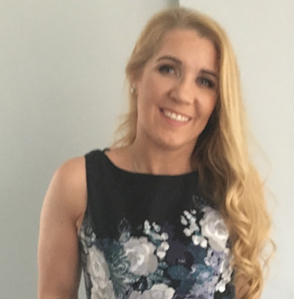 Leanne Ricciardelli, Senior Medical Scientist, Naas General Hospital.
Leanne Ricciardelli, Senior Medical Scientist, Naas General Hospital.
Leanne graduated with a BA. Mod. in Biochemistry from TCD and subsequently completed a post graduate transition programme to Medical Science and membership to the ASCLM in 2005. She completed her MSc in Molecular Pathology (Clinical Chemistry) with DIT in 2009. Leanne has been working as a Senior Medical Scientist in Clinical Chemistry in Naas General Hospital since 2010. In her spare time she plays a lot of volleyball and has represented Ireland internationally at both indoor and beach competitions.
Abstract: An extensive verification process was undertaken with the introduction of a new pilot data management system in Clinical Chemistry in Naas General Hospital. Detailed is the long journey involved from the project initiation to the go live day and beyond that to the ongoing management of the system.
13:30-14:00 Radionuclide Imaging of the Thyroid and Parathyroid glands to demonstrate functional and structural pathology
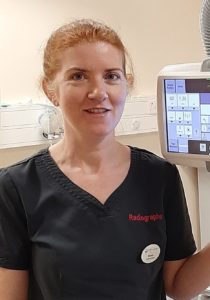 Róisín Bisland, Senior Radiographer & Clinical Practice tutor for UCD radiography students in Naas General Hospital.
Róisín Bisland, Senior Radiographer & Clinical Practice tutor for UCD radiography students in Naas General Hospital.
Róisín Bisland is a diagnostic radiographer who completed her degree in the UK in 1999. She worked in Tallaght University Hospital for 18 years and completed a Postgraduate Diploma in Nuclear Medicine in 2003 from Trinity College, Dublin. Róisín was the Clinical Specialist Radiographer in Nuclear Medicine in TUH for 6 years, overseeing an overhaul of the nuclear medicine department with the introduction of 2 new SPECT CT cameras in 2012, producing and updating departmental protocols in line with new developments, current literature and best practice guidelines.
Róisín moved to Naas General hospital in 2018 to take up a position of clinical practice tutor for undergraduate student radiographers on clinical placement from UCD in Naas General Hospital.
Abstract:
Róisín’s talk aims to give a demonstration of all aspects of radionuclide imaging of the thyroid and parathyroid gland. It provides an interesting link to how blood test results in the lab lead to the next step in the diagnostic process of thyroid and parathyroid disease.
To view the recording, register below:
Chair: Ciaran Love, Chief Medical Scientist, Cellular Pathology, Tallaght University Hospital
15:00-15:30 Update on Cellular Pathology Working Group on Medical Scientist Role Development
 Michelle Griffin, Chief Medical Scientist, Histopathology, Waterford University Hospital
Michelle Griffin, Chief Medical Scientist, Histopathology, Waterford University Hospital
Michelle Griffin (Ph.D., B.Sc., C.M.L.S., FACSLM) is the Chief Medical Scientist of the Histology Laboratory in University Hospital Waterford. Michelle has more than 15 years experience working as a Medical Scientist in Cork, Dublin and Waterford. Michelle has also worked as a Lecturer in CIT, NUIG and WIT and as a Post-Doctoral Researcher in CIT. Michelle has been a member of the ACSLM Cellular Pathology Advisory Body since 2015 and is currently the Chair of the Medical Scientist Skills Review Working Group.
Abstract
The Medical Scientist Skills Review Working Group was convened by the Academy of Clinical Science and Laboratory Medicine (ACSLM) at the request of the Medical Laboratory Scientists Association (MLSA) and commenced work in July 2020. The group consists of nine members from the ACSLMs Cellular Pathology Advisory Board (CPAB) and includes representatives from both clinical practice and educational fields.
The role of the Working Group is to assess available guidance on the Scope of Practice for Cellular Pathology Medical Scientists, review current workforce trends for Cellular Pathology Medical Scientists and to develop recommendations to allow Cellular Pathology Laboratories to safely react to Medical Scientist workforce trends while safeguarding service provision. This presentation provides an overview of the Working Group and an update on the work completed to date.
15:30-16:00 Cellular Pathology Skills Review Working Group: Updates
Anna Marie Purcell, Senior Medical Scientist, Mater Misericordiae University Hospital.
Senior Medical Scientist, Mater Misericordiae University Hospital.Anna Purcell is a Senior Medical Scientist (MSc, FACSLM) since 2007 in the Mater Misericordiae Hospital, Histopathology Laboratory. She is the Quality Lead for Histopathology laboratory and an active MMUH lean practitioner, chairing the MMUH Pathology Lean Practice group. She is a member of the ACSLM Cellular Pathology Advisory Body of which she chairs the CPAB Medical Scientist Role Development/ Allowances Working Group.
Abstract
The Cellular Pathology Advisory Body Medical Scientist Role Development/ Allowances Working Group was implemented in February 2020 consisting of 8 members of the CPAB committee. The role of the working group is to provide a framework for the development of recognised roles of Advanced Practice and Extended Scope of Practice for Cellular Pathology Medical Scientists and to draft a pay and allowance structure for these expanded duties. To date the group has raised two motions at the MLSA AGM of which both were passed relating to creation of a Consultant Grade Medical Scientist and Renumeration for Medical Scientist practising Histodissection. A recent survey was performed of Cellular Pathology laboratories establishing Histodissection activity nationally. The results and findings of this survey will be discussed in detail. Future Actions include drafting renumeration options for Histodissection and implementing a career framework for Medical Scientists to Consultants Grade.
To view the recording, register below:
On-Demand Content
Speakers:

Dr Brian Bird
Consultant in Medical Oncology

Dr Michèle Boisdron-Celle
Head of the Biopathology Lab
Integrated Center for Oncology, Angers, France and Co-Founder and President, ODPM

Jamie Cahalane
Business Development Manager Genomics and Speciality Testing
Eurofins Biomnis

Andrew Kenny
Chief Medical Scientist, Biochemistry
Bon Secours Hospital, Cork
Dr Jean-Philippe Metges
Oncologist specialised in digestive cancer, Professor at Cancer and Hematology Institute
Brest University Hospital

Linda Rattner Celle
International Marketing and Operations Director
ODPM
Fluoropyrimidines (FPs), including 5-fluorouracil (5-FU) and its pro-drugs are the most widely used chemotherapeutic agents for many types of solid tumours. Approximately 450, 000 patients in the EU are treated annually with FPs. They have a narrow therapeutic window with a small difference between the minimum efficacious dose and the maximum tolerable dose, with high interpatient variability. These drugs carry up to a 20% risk of Grade 3-5 toxicity and 0.2-1% risk of death, due to dihydropyrimidine dehydrogenase (DPD) deficiency. This is due in large part to the presence of variants in the DPYD gene, which codes for the DPD enzyme. In nature, DPD is responsible for the metabolism of endogenous pyrimidines, including uracil. DPD also functions as the rate limiting step in the metabolism of FPs. Thus, while FPs can be highly effective in treating cancer, severe, sometimes fatal, toxicities occur in a significant minority of patients, which represents an important public health problem. Recently, following a European Medicines Agency recommendation, the HPRA and the National Cancer Control Programme issued recommendations that DPD deficiency testing be carried out on all patients prior to fluoropyrimidine-based chemotherapy. There are several methods available for DPD deficiency testing. These include metabolic tests (dihydrouracil/uracil ratio), genomic tests for various SNIPs or a combination of metabolic and genomic tests. Here we review a combined, multiparametric, approach which integrates metabolic, genomic and physiologic data. This approach has been demonstrated to significantly reduce the rate of false negatives encountered with other methods. It can therefore reduce mortality and morbidity, improve patient outcomes and significantly reduce the costs associated with treatment for toxicity.
KEY POINTS:
- This multiparametric approach can predict 97.6% of lethal toxicities and 95.49% of severe toxicities to fluoropyrimidines
- Specific dosage is suggested by CE marked calculator for DPD deficient patients, giving these patients their best opportunity for positive outcomes
- Cost-benefit is positive – cost of testing all patients is less than treating the toxicities this test avoids
- PK-guided dose adjustment is available during treatment, also using the CE-marked calculator
To view the recording, register below:
By registering for this On-Demand Content, you agree to Step Exhibitions Ltd and ACSLM processing your data and sharing your data with those involved in the webinar/content. Step Exhibitions Ltd will never share your data with companies not associated with the webinar without your consent.
Speakers:

David Byrne
Marketing Manager UK/Ire.
Sakura Finetek

John Robinson
Business Manager Ireland
Sakura Finetek
Saving more than 200 staff days per year by automating embedding with the Tissue-Tek AutoTEC® a120
With challenges increasing in today’s histopathology labs such as staff shortages and increasing cancer numbers, the need to work smarter for faster results and provide higher quality is more important than ever..
Histopathology Labs are starting to change how they do things by embracing the latest technologies for automating repetitive manual processes and achieving greater standardisation, freeing up staff time, so that they can concentrate on those areas where their skills are most needed.
Join this webinar to hear more about automated embedding, hear evidence about Laboratories that have already made this change, reducing unnecessary repetitive manual work and using their time to the maximum benefit of the patient.
The average medium sized Laboratory embedding 500 blocks per day, can save in excess of 200 staff days per year by automating and standardising their embedding. Labs have used this staff time made free to decrease turnaround time to result, up skill-staff to perform other tasks, and to future proof their Labs for growth and increasing demands.
To view the recording, register below:
By registering for this On-Demand Content, you agree to Step Exhibitions Ltd and ACSLM processing your data and sharing your data with those involved in the webinar/content. Step Exhibitions Ltd will never share your data with companies not associated with the webinar without your consent.
Speakers:

David Byrne
Marketing Manager UK/Ire.
Sakura Finetek

John Robinson
Business Manager Ireland
Sakura Finetek
Imagine a world where you could concentrate on what matters most, where manual repetitive processes are reduced, where results are standardised where you can provide the best possible service for the patient in the shortest time?
What will that future look like? join Sakura to see a glimpse into that future with the new Tissue-Tek SmartConnect® automated transfer system.
Join us and step into your future.
Sakura Finetek Europe launches Tissue-Tek SmartConnect®, a new chapter in automation and the next step for laboratories in achieving future-proof pathology.
The Tissue-Tek SmartConnect solution enables a fully automated continuous flow by connecting processing and embedding in the histology lab. An automated transfer system that creates a continuous flow between the SMART solutions Tissue-Tek Xpress® x120 Rapid Tissue Processor and Tissue-Tek AutoTEC® a120 Automated Embedding System.
This new innovative SMART solution enables a laboratory to optimise their workflow and work more efficiently, eliminating repetitive and unnecessary manual work.
Laboratory technicians can focus more on what matters most: taking care of the best possible patient journey.
When it comes to diagnosing cancer, we can’t afford to wait for what happens next.
A helping hand in your laboratory
With an increasing rise in the number of cancer cases, we see laboratories working as hard as they can to deal with cases in the limited time they have. That’s why we believe they can use all the help they can get so they can work on what truly matters.
Meet SARA – The Smart Autonomous Robotic Assistant
To view the recording, register below:
By registering for this On-Demand Content, you agree to Step Exhibitions Ltd and ACSLM processing your data and sharing your data with those involved in the webinar/content. Step Exhibitions Ltd will never share your data with companies not associated with the webinar without your consent.
By Marco Bellini which is an overview of the new products from Milestone to help Anatomic Pathology laboratories in Sample handling and imaging.
To view the Webinar, register below:
By registering for this On-Demand Content, you agree to Step Exhibitions Ltd and ACSLM processing your data and sharing your data with those involved in the webinar/content. Step Exhibitions Ltd will never share your data with companies not associated with the webinar without your consent.
By Marco Bellini which is an overview of Milestone’s new Automated Tissue processor and embedding system.
To view the webinar, register below:
By registering for this On-Demand Content, you agree to Step Exhibitions Ltd and ACSLM processing your data and sharing your data with those involved in the webinar/content. Step Exhibitions Ltd will never share your data with companies not associated with the webinar without your consent.
Find out how to fast forward to next-generation imaging with the Aperio GT450 DX from Leica Biosystems. Using information from Pathology Departments across the globe, we designed our next-generation digital imaging system to meet your needs and help you deliver accurate results.
The Aperio GT 450 DX completes scanning tasks quickly leveraging a 32-second scan speed at 40x and an output of 81 slides per hour, delivering images with excellent image quality using Leica optics and with an IT architecture that is secure and flexible to scale up digital pathology solutions.
Designed to deliver rapid results with confidence for laboratory scientists, fast secure, and scalable IT architecture for IT professionals, and images with excellent image quality for Pathologists.
Easy to Use:
• No-touch operation – load and go
• Touchscreen displays a label and macro image
• Continuous loading while scanning
• Priority scanning
• Batch or single case scanning
• Option to scan entire slide at any time
Automated Image Quality Check:
• 99.5% accurate tissue finder
• 100% barcode read success
Streamlined Workflow:
• Directly load racks from the HistoCore SPECTRA Workstation
Security:
• Data encryption
• Strong password controls
• PIN control for scanners
Scalability:
• Centralised admin hub with high-performance SAM server that connects to multiple Aperio GT450 DX scanners in the lab – No more workstations for each scanner
• Mirth technology for event processing and data handling
Aperio DX Viewer:
• Medical grade calibrated 2K monitors
• Streamlined controls and multi-slide review
• Flip slides in tray option
• Text, shape, and measurement annotations
• 360o rotation, scrolling slide tray for up to 30 slides
To view the video, register below:
By registering for this On-Demand Content, you agree to Step Exhibitions Ltd and ACSLM processing your data and sharing your data with those involved in the webinar/content. Step Exhibitions Ltd will never share your data with companies not associated with the webinar without your consent.
Your time matters. To meet the ever-increasing workloads in the Cellular Pathology laboratory, speed up to slide processing while maintaining quality and consistency with the HistoCore SPECTRA Workstation, the only workstation that provides consistent staining from slides 1 to 1,600. It also offers the fastest glass coverslipping drying time on the market at only 5 minutes, processing slides that are instantly dry to the touch.
• Work harder. Process up to 570 dried slides per hour so you can transport immediately and not delay diagnosis.
• Improve efficiency by 20%. Unique flexibility to process H&E and special stains simultaneously at high throughput
• Save time. By using specifically-designed consumables, users ensure consistent staining quality and reduce the number of manual corrective actions for coverslipped slides.
Dual robotic arms and multiple reagent stations ensure each rack is stained efficiently. Users can process up to 330 slides per hour without compromising flexibility or lowering the turnaround time.
Precise control over reagent conditions, and coordinate reagent exchange using RFID-monitored consumables, color-coded rack technology, and a unique slide counter to minimize user errors, save time, control costs, and reduce waste.
Reduced Errors with Protocol Autostart
The patented color-coded rack technology automatically starts individual protocols when racks are inserted, reducing human error by automatically allocating racks and slides to their designated staining protocols.
Market-Leading Throughput and Drying Time
The only solution with dual glass coverslip lines enabling the highest throughput: up to 570 dried slides per hour. The integrated hot air drying oven achieves a drying time of only 5 minutes, providing the fastest turnaround time for your lab.
Large Workload Capacity
The 9-rack output drawer can handle a total capacity of 270 slides. That allows users to focus on the many other important tasks throughout the lab.
To view the video, register below:
By registering for this On-Demand Content, you agree to Step Exhibitions Ltd and ACSLM processing your data and sharing your data with those involved in the webinar/content. Step Exhibitions Ltd will never share your data with companies not associated with the webinar without your consent.
Speakers:

Bruce Bode, MD, FACE
Clinical Associate Professor
Dept. of Medicine Emory University

Jeffrey DuBois, PhD, HCLD/CC (ABB), FACP
VP Medical and Scientific Affairs
Nova Biomedical
Diabetes and stress hyperglycemia are two of the most common co-morbidities of COVID-19. Two recent multicenter studies of 8,500 COVID-19 hospitalized patients have found that type 2 diabetes (T2D) diabetes and poor glycemic control are risk factors for COVID-19 disease progression and adverse outcome. This webinar will review clinical characteristics and mortality of COVID-19 patients with pre-existing T2D, and possible avenues to improving their disease outcomes. Clinical evidence supporting tight glycemic management of T2D during COVID will be presented.
The webinar will also describe the growing interest in the antioxidant properties of ascorbic acid as an adjunctive therapy for COVID-19. For these critically ill patients, severe anemia is also a common underlying condition. This webinar examines the risk of inaccurate glucose meter results due to interference from ascorbic acid and anemia. A glucose meter that measures and corrects for these interferences will also be described.
Click here to view the webinar
Speaker:

Bogdan Milojkovic, MD,PhD
Global Director, Medical and Scientific Affairs
Nova Biomedical
Respiratory distressed COVID-19 patients require a comprehensive point-of-care test menu to manage their care. This seminar will examine the essential role of an expanded blood gas/critical care test menu, which includes ionized magnesium, BUN,and creatinine, for managing acute respiratory distress COVID-19 and its co-morbidities: sepsis, stress hyperglycemia, acute kidney injury and arrhythmia.
Key Learning Points:
• Review COVID-19 facts
• Discuss Management of critical Covid-19 patients
• Review critical care parameters in the management of COVID-19
Click here to view the webinar
For more than 2000 years, the participation of women in research, and, more widely, in the public sphere outside the home, has been controversial. Some 300 years before the birth of Christ, Aristotle, the famous philosopher, was of the opinion that the physical texture of women’s brains made women incapable of rational thought. Fast forward to 2020 when two women shared the Nobel prize in chemistry. This win made headlines because of their groundbreaking research into the so-called genetic scissors, CRISPR, and because it was the first time two women won this prize without having to share it with a man. One of the researchers Jennifer Doudna said that she hoped that this had broken the glass ceiling so that in future it is not surprising that two women or more win awards.


